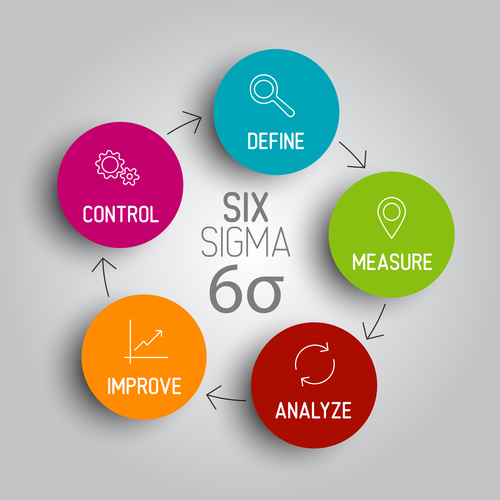What Is Six Sigma?
There are many moving parts to Six Sigma, but in a few words, one can define it as a systematic approach for eliminating errors.

You can also listen this article:
It is data-driven and statistical-based with the primary goal of the continuous improvement in quality and the elimination of defects in products and services by minimizing variability in business processes.
Six Sigma is a disciplined and quantitative method that focuses on improving quality in manufacturing. By using measurements and collecting data, the goal becomes to remove errors and add consistency to the processes, which will result in a quality product.
Six Sigma tackles not only the production of a product but also its design. The acronyms DMAIC and DMADV represent the two approaches:
Six Sigma DMAIC
The Six Sigma DMAIC method contains five steps that are typically used to improve an existing process or product. The steps are:
- Define the problem: Determine the goals, resources, and limits for a solution.
- Measure the current process: Collect data on the existing method or system.
- Analyze the data: Identify the cause of the variations or errors.
- Improve the process: Modify the methods to reduce or eliminate the defect.
- Control the process: Provide a system that allows monitoring and adjustments to prevent similar defects in the future.
Six Sigma DMADV
When designing a new product or service, organizations use the Six Sigma DMADV. It can also be useful in improving existing processes. Here’s how DMADV works:
- Define design standards: Establish methods that support the product and the process goals.
- Measure and identify: Determine which of the product’s characteristics are critical to quality.
- Analyze the data: Identify possible sources of defects and develop alternative designs.
- Design changes: Select the alternative design that will eliminate the source of defects or errors.
- Verify the changes: Ensure that the design will meet the requirements of the project.
Six Sigma’s bases its success on several strategic principles:
Focusing on the customer
Six Sigma is built around an unswerving pursuit of improving quality. First of all, it’s important to define what “quality” means, and it’s essential that the definition comes from the perspective of the customer. Businesses must be measuring quality just as its customers do. Focusing on the customer can help any company to improve its product’s overall quality.
You might also like: How Manufacturing ERP Improves Quality in the Workplace.
Identifying root causes
Businesses must understand their processes entirely before they can determine a root cause correctly. It’s not enough to know how the process was designed to work. It’s more about understanding how the process is actually working. Finding this requires the following:
- Having well-defined goals for collecting data
- Identify the data
- Defining a reason for collecting the data
- Establishing what insights everyone should expect from the information
- Ensuring clear communication
- Making sure that all measurements are correct and can be repeated

After the data has been collected, it’s time to determine whether it is providing the necessary understanding and is meeting the established goals. If it isn’t, improve the data collection plan and come up with further information.
Data collection includes interviews, observations, and asking questions until there are answers. Use the collected data to find ways to improve or optimize the process by identifying the root cause of the error or variation.
Eliminating variations
After the root causes have been pinned down, it’s time to make changes that will result in the elimination of disparities and defects and to do away with waste by excluding any steps in the process that do not add any value for the customer.
Rather than waiting for signs of variation, Six Sigma advises being preemptive in identifying and removing it. By collecting and studying data, along with speaking to anyone that’s involved in the process, it’s possible to find issues in the process that were perpetuated merely because they had always been done a certain way.
Taking responsibility
Six Sigma is made up of teams and leaders who are willing to take responsibility for the processes. Everyone on the teams must be trained in the Six Sigma methods that include measurement methods and improvement tools. Excellent communication skills are required so they can connect effectively with both customers and coworkers.
Teams with members who have an assortment of skills and backgrounds will help the team to spot variations quickly. In a manufacturing setting, workers from maintenance, purchasing, engineering, and production would be excellent choices for the team.
Being flexible and methodical
Six Sigma is about flexibility. Not only does management need to be receptive to positive changes, but they must also be willing to encourage them. As for the workers, they should be inspired to adapt to them. It’s vital that the benefits of the changes be communicated to all employees so that they are more inclined to accept them.
The key to Six Sigma’s success will be the organization’s ability to adopt new procedures as they are needed. In other words, the process required for change should be as uncomplicated as possible so that both management and workers are not so frustrated that they would prefer the broken process to the improved one.
Six Sigma also requires that problem-solving be methodical and thorough. New or updated processes work best when everyone understands each feature of the process, including the steps and the workers who will be involved.
Six Sigma’s Belt System
Many proponents of Six Sigma believe that one of its greatest strengths in managing those who use it might be its belt system. The system is made up of rankings that are similar to those used in the martial arts. The belt system establishes a chain of command among those employees with Six Sigma training. The rankings help them understand their roles on project teams and what will be expected of them.
While there are several roles in Six Sigma belt ranking, here are four of the most noteworthy:
- Champions are those individuals–typically from upper management—who act as sponsors and leaders to implement Six Sigma projects.
- Master Black Belts have the most Six Sigma training and experience in the organization. They maintain a close connection with upper management and provide advice and training to the lower ranking belts.
- Black Belts are full-time Six Sigma professionals who assist in picking Six Sigma projects. They train team members and help them design experiments and analyze data.
Green Belts are generally part-time Six Sigma adherents who spend around 25% of their time working on Six Sigma projects.
You might also like What is Kaizen?



